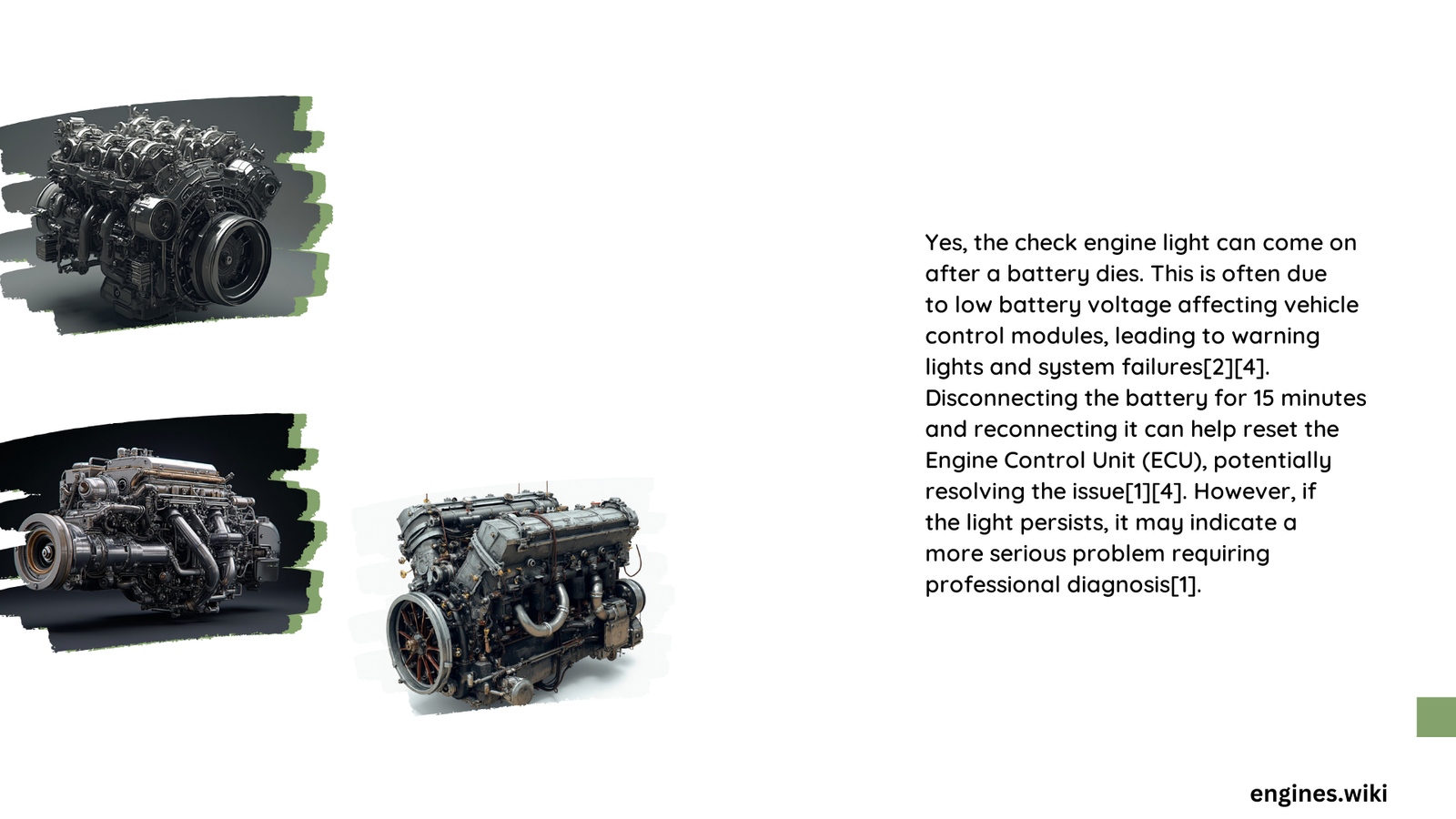The check engine light typically does not activate immediately after a vehicle’s battery dies. However, it may illuminate if the battery failure affects various vehicle systems monitored by the onboard diagnostics (OBD) system. This can occur due to low voltage conditions, communication issues with control modules, or system voltage abnormalities. Understanding the relationship between battery failure and the check engine light is crucial for proper vehicle maintenance and troubleshooting.
What Causes the Check Engine Light to Illuminate After a Battery Dies?
When a vehicle’s battery dies, it can trigger a series of events that may lead to the check engine light coming on. Here are some common reasons:
-
Low System Voltage: A dead battery can cause the system voltage to drop below the required threshold for proper operation of various vehicle systems.
-
Communication Errors: Low voltage can disrupt communication between different control modules in the vehicle, leading to error codes.
-
Sensor Malfunctions: Some sensors may not function correctly under low voltage conditions, triggering fault codes.
-
Memory Reset: When the battery dies completely, it can cause the vehicle’s computer to lose its stored settings and adaptive learning data.
What Are the Common DTCs Associated with Battery Failure?

Diagnostic Trouble Codes (DTCs) are codes stored by the vehicle’s onboard computer when it detects a problem. Several DTCs can be associated with battery failure or related issues:
| DTC Code | Description | Possible Cause |
|---|---|---|
| U0100 | Lost Communication with Engine Control Module (ECM) | Low battery voltage affecting ECM operation |
| U0101 | Lost Communication with Transmission Control Module (TCM) | Battery voltage drop affecting TCM |
| P0560 | System Voltage | Abnormal system voltage due to failing or dead battery |
| P0562 | System Voltage Low | Battery voltage below the required threshold |
| P0563 | System Voltage High | Overcharging or alternator issues |
These codes can provide valuable information about the nature of the battery-related problem and guide the troubleshooting process.
How Does Battery Failure Impact Vehicle Systems?
Battery failure can have far-reaching effects on various vehicle systems:
-
Engine Management: Low voltage can affect fuel injection and ignition systems, leading to poor engine performance.
-
Transmission Control: Communication issues with the TCM can cause erratic shifting or transmission problems.
-
Emissions Control: Proper functioning of emissions control systems may be compromised, potentially increasing emissions.
-
Electrical Accessories: Power windows, radio, and other electrical components may malfunction or cease to operate.
-
Safety Systems: Some safety features, like airbags or ABS, may be affected by low voltage conditions.
What Steps Should Be Taken to Reset the Check Engine Light After a Jump Start?
After jump-starting a vehicle with a dead battery, the check engine light may remain illuminated. Follow these steps to reset it:
-
Ensure the battery is fully charged by letting the vehicle run for at least 15-20 minutes.
-
Connect an OBD-II scanner to the vehicle’s diagnostic port.
-
Read any active or pending DTCs to identify potential issues.
-
If the battery is now fully charged and no other issues are present, clear the DTCs using the scanner.
-
Disconnect the scanner and start the vehicle to verify that the check engine light has turned off.
-
If the light remains on, further diagnosis may be necessary.
When Might the Check Engine Light Remain On After a Battery Replacement?
In some cases, the check engine light may persist even after replacing the battery. This can occur due to:
-
Unresolved Issues: If the battery failure was a symptom of a larger problem (e.g., alternator malfunction), the light may stay on.
-
Pending Codes: Some vehicles require a certain number of drive cycles before clearing pending codes.
-
Adaptive Learning Reset: The vehicle’s computer may need time to relearn certain parameters after a complete power loss.
-
Sensor Calibration: Some sensors may require recalibration after a battery replacement.
If the light remains on after several drive cycles, it’s advisable to have the vehicle inspected by a professional mechanic.
What Preventive Measures Can Be Taken to Avoid Battery-Related Check Engine Light Issues?
To minimize the risk of battery-related check engine light problems:
-
Regular Battery Maintenance: Check the battery’s charge level and condition periodically.
-
Proper Charging: Ensure the alternator is functioning correctly to maintain proper battery charge.
-
Avoid Deep Discharges: Try not to let the battery discharge completely, as this can shorten its lifespan.
-
Address Warning Signs: Pay attention to signs of a failing battery, such as slow cranking or dimming lights.
-
Use a Battery Tender: For vehicles not used regularly, a battery tender can help maintain the charge.
-
Quality Replacement: When replacing the battery, choose a high-quality unit that meets or exceeds the vehicle’s specifications.
By following these preventive measures, you can reduce the likelihood of experiencing battery-related check engine light issues and ensure better overall vehicle performance.
